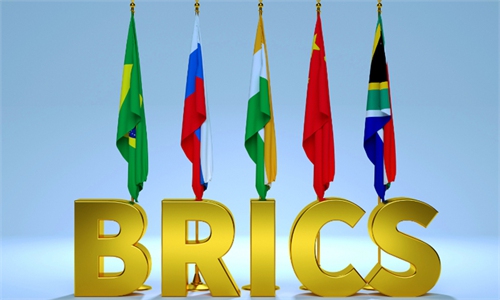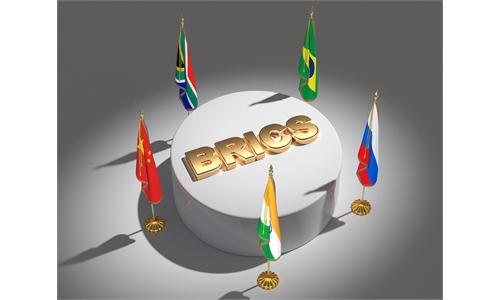BRICS expected to roll out deepened cooperation mechanism on currency, in push to reduce reliance on dollar
With more countries applying to join the group, process of de-dollarization expected to accelerate: expert

A city view shows Johannesburg in South Africa where the BRICS Summit 2023 will be held from August 22 to 24, 2023. Photo:VCG
As a growing number of emerging economies and developing countries are reeling from the US' consecutive rates hikes and a strengthening greenback, BRICS, an emerging-market group that includes Brazil, Russia, India, China and South Africa, renders a powerful force in propelling the de-dollarization process.
In the upcoming BRICS 2023 summit scheduled to be held in South Africa from August 22 to 24, the first in-person BRICS summit since the COVID-19 pandemic, the rollout of deepened cooperation mechanism among its members on currency has been highly anticipated.
The countries will discuss deepening the use of local currencies in trade, which is "firmly on the agenda," and a technical committee is likely to be formed to start considering a potential joint currency, South Africa's BRICS Sherpa Anil Sooklal said in an interview with the Bloomberg on Monday.
The BRICS members have been striving to settle more trade in their own currencies over recent years as part of broader efforts to gain economic clout and counterbalance the hegemony of the US dollar.
Earlier this month, Brazilian President Luiz Inacio Lula da Silva reiterated over a breakfast with foreign correspondents in the capital city Brasilia that BRICS members should consider developing a joint currency to reduce reliance on the US dollar, according to a report by China Media Group.
The South American country reached a deal with China in March this year to trade in their own currencies, ditching the US dollar as an intermediary. The deal enables China and Brazil to conduct their massive trade and financial transactions directly, exchanging the Chinese currency yuan for Brazil's reais and vice versa, instead of going through the dollar.
Besides the China-Brazilian teaming-up, the usage of local currencies between China and Russia is also on the rise along with the increase of bilateral trade, and the yuan is seeing more presence in Russia's economic activity.
Over 80 percent of trade settlement between Russia and China is now conducted in Russian rubles and Chinese yuan, Russian President Vladimir Putin said at the opening of the SCO summit on July 4, according to a report by Russian News Agency TASS.
"The rising usage of local currency has become a widespread alternative to US greenback, which is a long-term trend, despite the influence of local currency approach is still limited at current phase," Niu Haibin, director of the Institute for Foreign Policy Studies from the Shanghai Institutes for International Studies, told the Global Times on Tuesday.
The New Development Bank, a lender created by BRICS in 2015, has set the target to increase local currency lending to 30 percent by 2026.
Among the non-dollar currencies, the yuan has showcased its advantage in terms of stability in supporting trade with other countries, conducive to the currency's internationalization and the resilience of international monetary system, Niu said.
Indian Oil Corp, India's biggest buyer of Russian crude oil, in June became the first state refiner to pay for some Russian purchases in the yuan, according to a Reuters report.
Weaving a non-dollar web
BRICS members have generally demonstrated their strong intentions to push ahead the non-dollar adoption in their trade, but the process is not balanced, posing a challenge to the potential joint currency, according to Niu.
"For example, the currency cooperation between China and Russia, between China and Brazil is picking up momentum, while that between China and India turned out to be lackluster," he noted.
India has previously raised concerns that the introduction of a joint currency will only further increase dependence on China's yuan.
Undeniably, the BRICS economies differ substantially in terms of economic composition, monetary policy, trade, growth and financial openness. But that should not hinder the common goal of getting rid of the "kidnapping" of high costs by transactions in the greenback, experts said.
If a country's currency is pegged to the US dollar, it needs to keep up with US monetary policy and consume a lot of money to maintain the exchange rate with the dollar. When the volume of trade is massive, the cost will become very high.
Tan Xiaofen, an expert with the School of Finance at the Central University of Finance and Economics, told the Global Times on Tuesday that that de-dollarization has shown an irreversible trend in terms of international trade valuation and settlement, although the US greenback is still in a dominant position.
Data from the Bank for International Settlements showed that the dollar accounted for about 90 percent of the global currency transaction volume in 2022, followed by the euro with a 31 percent share. The yuan accounted for about 7 percent of global foreign exchange transaction volume last year. As the two currencies are involved in each transaction, the sum of shares in individual currencies will total 200 percent, according to the data.
"The Russia-Ukraine conflict, the COVID-19 pandemic, and other geopolitical factors have made many countries rethink about financial security," said Tan.
The joint currency being considered among BRICS countries is likely to be a kind of reserve money, which is similar to the Special Drawing Rights (SDR) arrangement by the IMF, according to Niu.
SDR is not a currency, but a potential claim on the freely usable currencies of IMF members.
With more countries showing their interests in joining the BRICS, which looks to provide development tools based on close partnership and shared growth, in comparison with the Western model that pursues its own interests, the non-dollar currency cooperation could be further expanded, weaving a bigger and bigger web, Niu said.
Currently, the BRICS members represent nearly 42 percent of the global population and account for about 26 percent of the global economy, according to media reports.
According to the government of South Africa, more than 40 countries have expressed interest in joining the bloc.
"No matter how far the BRICS countries can push forward their currency cooperation, it will be an accelerator for global de-dollarization and will also help the internationalization of the yuan," Niu said.



